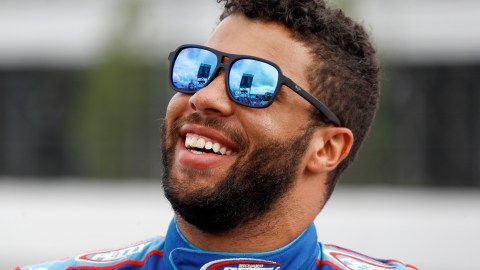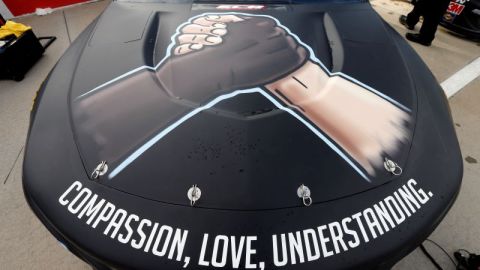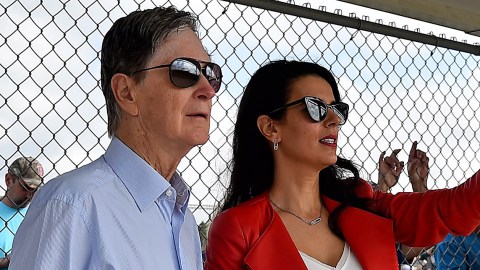 WALTHAM, Mass. — The lineup adjustment that saved the Celtics’ season last year was described in shorthand — both at the time and in retrospect — as moving Kevin Garnett to center. Anyone who watched the Celtics play from beginning to end noticed their drastic improvement after the All-Star break and in the playoffs, when a smaller, more versatile group spearheaded a surprising run to the Eastern Conference Finals.
WALTHAM, Mass. — The lineup adjustment that saved the Celtics’ season last year was described in shorthand — both at the time and in retrospect — as moving Kevin Garnett to center. Anyone who watched the Celtics play from beginning to end noticed their drastic improvement after the All-Star break and in the playoffs, when a smaller, more versatile group spearheaded a surprising run to the Eastern Conference Finals.
In reality, very little of Garnett’s role changed. He still was the active and talkative anchor of the Celtics’ back line, and he still did much of his offensive work from midrange or the perimeter. When the lights went out before tip-off, though, Garnett was introduced as the center. That was pretty much the only thing that was new.
The fact is, it just sounds sexier to say the Celtics’ improvement happened after Garnett moved to center and not after Brandon Bass became the starting power forward. Neither player’s new label on its own accounted for the Celtics’ 24-10 record after the All-Star break. Rather, the improvement came after Celtics coach Doc Rivers threw off the limitations of a traditional lineup and decided to put his five most effective players on the floor, as he did toward the end of Boston’s championship season in 2007-08.
This is a long way of explaining why the NBA’s decision to remove the “center” designation from the All-Star ballot starting this season is a move past due. The rest of the league has been doing this sort of stuff for years, but it came to prominence last spring. Like the Celtics, the Heat found success with an unconventional lineup last season, although it took Miami coach Erik Spoelstra a bit longer to discover his perfect combination with Chris Bosh at the pivot. Before that, converted power forwards like Al Jefferson manned the middle, and Tim Duncan finally became the center he has been in actuality (if not in name) for most of his career.
The reason for all this jockeying is simple: There are 30 NBA teams, but there are not 30 human beings with the size and coordination to play true center at the highest level. Football ran into this same problem with its quarterbacks, which prompted the rise of the read-option, the Wildcat and other ways to move the ball without throwing. The NBA’s size crisis actually goes back farther than many people assume. The 1990s was a golden age of great centers with Hakeem Olajuwon, Patrick Ewing, David Robinson and Shaquille O’Neal muscling for position down low, but three-quarters of the league was so desperate for big men, the defending NBA Finalist SuperSonics threw more than $3 million a year at Jim McIlvaine.
Now, Dwight Howard is the best center in the NBA, although his competition is sparse. Andrew Bynum has a decent array of post moves. Tyson Chandler is outstanding defensively and in the pick and roll. Roy Hibbert keeps steadily improving amid relative anonymity in Indianapolis. Joakim Noah is annoying to opponents, but only because he is so disruptive on defense and on the glass. Marc Gasol is an adept passer and defender who still does not rebound well enough to deserve elite status. After them comes… who?
Garnett has the height of a center, but on a given possession he may shift from the five to the four to the three. Andrew Bogut needs to figure out how to stay healthy. Brook Lopez, JaVale McGee, DeMarcus Cousins and DeAndre Jordan have lots of work to do.
Even with the change to the ballot, not much will change for the West All-Stars this year. Howard, Blake Griffin and Kevin Durant would be the starting frontcourt even if the ballot were printed in Arabic. Things could get interesting in the East, though. LeBron James and Carmelo Anthony are locks. Based on last year’s voting, Bynum would start as well, giving the East a traditional look, but it remains to be seen if Bynum maintains his star power outside of Los Angeles once he gets onto the court for the Sixers. Forwards-turned-centers Garnett and Bosh would be the new frontrunners, but Paul Pierce could nudge into the debate with a strong start. Who out of a potential starting frontcourt of James, Anthony and Pierce would be the “center?”
Complications like that kept Rivers, who is a member of the NBA’s competition committee that voted on the ballot change, from pushing for an even more liberal All-Star roster made up of simply the 12 best players with the five top vote-getters starting, regardless of position. Guards and wing players typically are more popular than big men — although Howard received the most votes last year and Yao Ming‘s fans in China notoriously stuffed the ballot box — and even as a former point guard, Rivers recognizes the importance of acknowledging the big men.
“That’s why you have to [divide] it for the starting lineup,” Rivers said. “Hell, you could have five guards versus five bigs — that’d be fun, actually — but I don’t think we’ll ever do that.”
Within a few years, however, a starting lineup consisting of three “small” forwards might not look so odd. The Celtics have tinkered with lineups that include Pierce, Bass and Jeff Green along the front line, and Green has done everything from post up to direct the offense this preseason. The moves prompted Green to declare traditional positions — for his team, anyway — “completely gone.”
“There’s a lot of teams playing small ball right now,” Green said. “You’ve got to be able to match up with them if you want to be able to win.”
One of the few teams that figured to have an old-school lineup took a hit this week. The Knicks spent big in 2011 to sign Chandler, and the former No. 2 overall draft pick responded by being the team’s best player last season. But while setting a screen in Wednesday’s preseason game, Chandler’s left knee buckled and he had to be helped off the court. The Knicks’ front line, which was already hurting from Amar’e Stoudemire‘s knee injury, may get even thinner.
If Chandler, who was diagnosed with a left knee bone bruise on Thursday, misses a significant portion of the season, Knicks coach Mike Woodson will face a conundrum. Like the vast majority of coaches in the NBA, Woodson will have to cobble together a game plan without an All-Star center — a label that came to mean less and less over the years and now no longer exists.
Have a question for Ben Watanabe? Send it to him via Twitter at @BenjeeBallgame or send it here.



